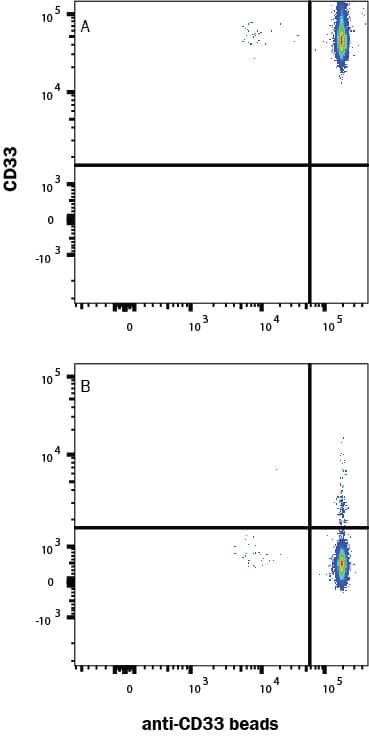Recombinant Human Siglec-3/CD33 Protein, Atto 488 Conjugate
R&D Systems, part of Bio-Techne | Catalog # ATJ1137

Key Product Details
Source
Accession #
Structure / Form
Excitation Wavelength: 501 nm
Emission Wavelenght: 523 nm
Conjugate
Applications
Product Specifications
Source
| Human Siglec-3/CD33 (Asp18-His259) (Val257Leu) Accession # AAA51948.1 |
DIEGRMD | Human IgG1 (Pro100-Lys330) |
| N-terminus | C-terminus |
Purity
Endotoxin Level
N-terminal Sequence Analysis
Predicted Molecular Mass
SDS-PAGE
Activity
Measured by flow cytometry for its ability to bind anti-Human Siglec-3/CD33 Monoclonal Antibody conjugated fluorescent beads.
Scientific Data Images for Recombinant Human Siglec-3/CD33 Protein, Atto 488 Conjugate
Detection of Human Siglec-3/CD33 Antibody with Recombinant Human Siglec-3/CD33 Protein, Atto 488 Conjugate by Flow Cytometry.
Fluorescent beads conjugated to anti-Human Siglec 3/CD33 Monoclonal Antibody (MAB1137) were stained with (A) Recombinant Human Siglec 3/CD33 Protein, Atto 488 Conjugate (Catalog # ATJ1137) or (B) unstained.Recombinant Human Siglec-3/CD33 Protein, Atto 488 Conjugate SDS-PAGE.
2 μg/lane of Recombinant Human Siglec-3/CD33 Protein, Atto 488 Conjugate (Catalog # ATJ1137) was resolved with SDS-PAGE under reducing (R) and non-reducing (NR) conditions and visualized by Coomassie® Blue staining, showing bands at 67-80 kDa and 134-160 kDa, respectively.Formulation, Preparation and Storage
ATJ1137
| Formulation | Supplied as a 0.2 μm filtered solution in PBS with BSA as a carrier protein. |
| Shipping | The product is shipped with dry ice or equivalent. Upon receipt, store it immediately at the temperature recommended below. |
| Stability & Storage | Protect from light. Use a manual defrost freezer and avoid repeated freeze-thaw cycles.
|
Background: Siglec-3/CD33
Siglecs (sialic acid binding Ig-like lectins) are I-type (Ig-type) lectins belonging to the Ig superfamily. They are characterized by an N-terminal Ig-like V-type domain which mediates sialic acid binding, followed by varying numbers of Ig-like C2-type domains (1, 2). Eleven human Siglecs have been cloned and characterized. They are sialoadhesin/CD169/Siglec-1, CD22/Siglec-2, CD33/Siglec-3, Myelin-Associated Glycoprotein (MAG/Siglec-4a) and Siglecs 5 to 11 (1 - 3). To date, no Siglec has been shown to recognized any cell surface ligand other than sialic acids, suggesting that interactions with glycans containing this carbohydrate are important in mediating the biological functions of Siglecs. Siglecs 5 to 11 share a high degree of sequence similarity with CD33/Siglec-3 both in their extracellular and intracellular regions. They are collectively referred to as CD33-related Siglecs. One remarkable feature of the CD33-related Siglecs is their differential expression pattern within the hematopoietic system (1, 2). This fact, together with the presence of two conserved immunoreceptor tyrosine-based inhibition motifs (ITIMs) in their cytoplasma tails, suggests that CD33-related Siglecs are involved in the regulation of cellular activation within the immune system. Human Siglec-3 is alternatively known as myeloid cell surface antigen CD33 and GP67. Human Siglec-3 cDNA encodes a 364 amino acid (aa) polypeptide with a hydrophobic signal peptide, an N-terminal Ig-like V-type domain, one Ig-like C2-type domains, a transmembrane region and a cytoplasmic tail (1, 4). Siglec-3 expression is restricted to cells of myelomonocytic lineage (2). It binds sialic acid preferring alpha2,3- linkage over alpha2,6- linkage (5). Studies indicated that Siglec-3 recruits SHP-1 and SHP-2 to its ITIMs (6, 7). When co-crosslinking with Fc gammaR1, Siglec-3 inhibits tyrosine phosphorylation and calcium mobilization, suggesting Siglec-3 can mediate inhibitory signals (7).
References
- Crocker, P.R. and A. Varki (2001) Trends Immunol. 22:337.
- Crocker, P.R. and A. Varki (2001) Immunology 103:137.
- Angata, T. et al. (2002) J. Biol. Chem. 277:24466.
- Simmons, D. and B. Seed (1988) J. Immunol. 141:2797.
- Freeman, S.D. et al. (1995) Blood 85:2002.
- Taylor, V.C. et al. (1999) J. Biol. Chem. 274:11505.
- Ulyanova, T. et al. (1999) Eur. J. Immunol. 29:3440.
Long Name
Alternate Names
Gene Symbol
UniProt
Additional Siglec-3/CD33 Products
Product Documents for Recombinant Human Siglec-3/CD33 Protein, Atto 488 Conjugate
Product Specific Notices for Recombinant Human Siglec-3/CD33 Protein, Atto 488 Conjugate
For research use only

